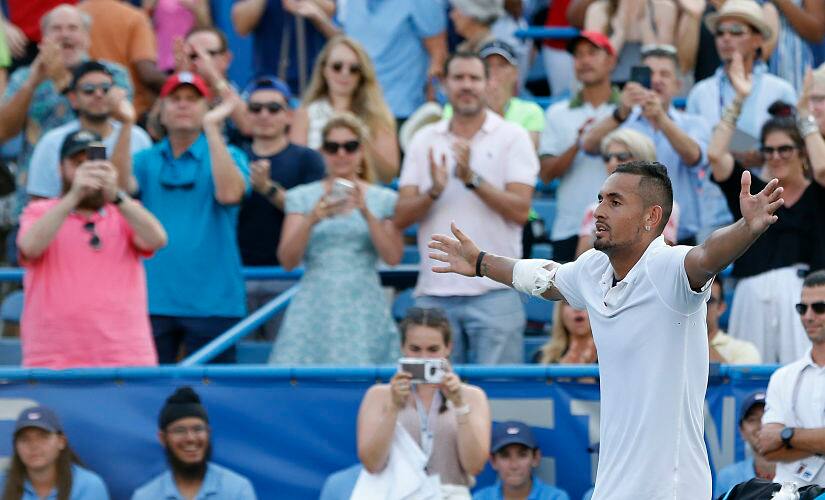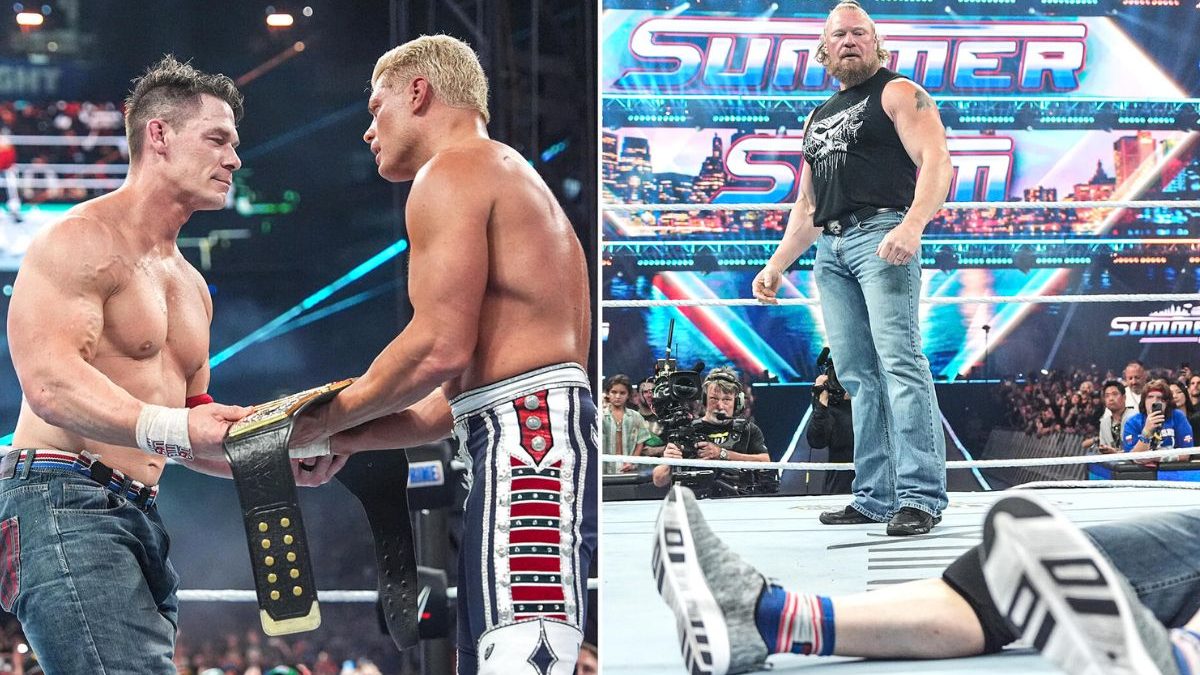It has become something of a clarion call for the tennis universe. A Nick Kyrgios match could be chugging along unremarkably, but then he brings out one of his out-of-the-box plays – it could be a tweener, or an under-arm serve, or a verbal joust with the spectators – and you know you have to sound out the alarm far and wide. Things are about to heat up, you scream at everyone around you. You wouldn’t want to miss it for the world, you insist to an increasingly intrigued audience. It is Kyrgios’ own ‘Mahi maar raha hai’ moment, and it always sells like hot cakes. That the sign of Kyrgios’ impending explosiveness is not a big serve or a brilliant winner but a trick shot that isn’t necessarily designed to make him a champion, rankles deeply with the connoisseurs of the sport. The question of when will he stop faffing about and get serious about winning has been asked repeatedly over the last five years, often with pursed lips and an impatient glare. [caption id=“attachment_7112241” align=“alignnone” width=“825”]  Nick Kyrgios celebrates after beating Daniil Medvedev to win Citi Open in Washington. Reuters/USA Today Sports[/caption] No, Kyrgios’ win in Washington this week hasn’t answered that question. He may have produced some sharp tennis to defeat high-quality opponents like Gilles Simon, Stefanos Tsitsipas and Daniil Medvedev, but in the past he has produced sharper tennis to defeat higher quality opponents (read Roger Federer, Rafael Nadal and Novak Djokovic). We have seen it all before, and we know from experience that what follows isn’t always pretty. This title – the sixth of Kyrgios’ career – is not going to be the catalyst for him to turn everything around and become the dominant player we have always tipped him to be. He is just as likely to lose to an unheralded player now as he was a week ago, or even five years ago. Sure, the Washington win is a reinforcement of the idea that on the rare occasions when Kyrgios is focused for an entire week, he is pretty close to unbeatable. But again, we knew that already. “It’s been one of the best weeks of my life from a tennis perspective,” Kyrgios said after the match, and that was neither a new revelation nor a surprising admission. When the Australian is not winning titles, he is usually losing in the first or second round; of course this had to be one of the best weeks of his tennis career. But this title did give us a new insight: that the ATP 500, or middle-tier tournament, is the likeliest platform to bring out Kyrgios’ best. We’ve known for a while now that Kyrgios finds it tough to get motivated against lower-ranked players. The fact that he defeated Thai-Son Kwiatkowski and Norbert Gombos in the past week was perhaps more shocking than any of the other things he did for shock value. So it naturally follows that a 250 tournament – the lowest rung in the ATP’s hierarchy of tournaments – would also do little to get Kyrgios’ competitive juices flowing. At the other end of the spectrum, the Grand Slams and Masters tournaments are a little too physically taxing for the Australian and his seemingly sub-par conditioning. The best-of-five sets format of the Slams is self-explanatory, but even the Masters have one additional match compared to the other tournaments, and they are usually longer contests due to the higher level of competition. A 500 tournament fits snugly between those two extremes. The competition is neither too easy nor too difficult, and the crowd is neither too big and boisterous nor too quiet and unexcitable. With the spotlight shining just as brightly as Kyrgios is comfortable with, he tends to be more relaxed and loose at 500 tournaments than he is at others. He was certainly loose and relaxed in his semifinal against Tsitsipas, which will likely make it to most shortlists for the best matches of 2019. Kyrgios vs Tsitsipas is everything you’d want in a tennis rivalry; it is the matchup we didn’t know we needed, but which we now can’t live without. It helps that the two also forged a much-talked-about doubles partnership in the week, which produced its share of highlights-reel moments despite crashing out in the first round itself.
El puntazo de Tsitsipas y Kyrgios en el cuadro de dobles del #CitiOpen. pic.twitter.com/gnvMW1mmT6
— David Boti (@davidboti) July 30, 2019
Kyrgios and Tsitsipas are diametrically opposite in the intensity levels they bring to the court, which is perhaps why their spectacular shot-making skills acquire an added allure when placed next to each other. Kyrgios has the bigger serve and forehand, Tsitsipas has the wider angles and quicker feet, and they both have the delicate touch and extravagant flair for theatre. Together, they make for a dynamite display. The Aussie and the Greek brought all of their considerable skills to bear on one glorious night of tennis nirvana in Washington, and the fans couldn’t stop counting their blessings. The closely fought battle, which required a third-set tiebreaker and saw multiple match point saves, seemed like a long and varied trick show filled with sensational shots and supernatural gets. The match was dead even in many statistical aspects too, which added further to its mythical quality. Both Kyrgios and Tsitsipas won 91 points each, broke serve twice each, and most spookily of all, won 48 of 58 first serve points and 16 of 33 second serve points each. It was a night of black magic.
The #CO19 fans should start charging consulting fees! 😂
— ATP Tour (@atptour) August 4, 2019
🎥: @TennisTV | @NickKyrgios pic.twitter.com/AJGhvuDbHy
Kyrgios’ win over Medvedev in the final wasn’t quite as memorable, but that’s only because he played within himself for a majority of it. Struggling with a back injury right from the start, the Australian was content to take both sets to the tiebreaker , where his superior serve was bound to make a difference. But even in a match as straightforward as this, there were a couple of points that brought Kyrgios’ underrated tennis IQ to the fore once again. Medvedev was 5-4 up in the first set tiebreaker with two serves to come, when Kyrgios suddenly unloaded on a crosscourt backhand to elicit a short reply from the Russian. Presented with a wide open court Kyrgios got in position to crush a crosscourt forehand, but pulled out at the last moment and caressed a forehand dropper down the line instead. The disguise was too good; Medvedev didn’t even bother to chase it down. A couple of minutes later Kyrgios went for the drop shot again, but this time as a means to set up the point rather than finish it. He lured Medvedev to the net, and then calmly stroked a forehand pass up the line to earn a set point – which he promptly converted. Aside from that, there were the usual tweeners (at one stage he hit two in a single game), under-arm serves and no-look faked shots that kept everyone, except Medvedev, entertained. The proof of the pudding was in the frequent roars of approval from the crowd; no matter what he does, Kyrgios remains a huge fan favourite and a veritable newsmaker. But is it just me, or has Kyrgios lately been attracting a little more attention than usual? He has won back-to-back matches just thrice this year, and yet on social media he seems to be the most important player on tour outside the Big 3. Yes, the chair-throwing incident in Rome was a little extreme even by his standards, but for the most part - in 2019 - he’s been his usual self. Kyrgios has, by turns, been cocky, brilliant, sarcastic, funny, self-destructive and friendly. And sometimes he has been all of these things at the same time. His Washington run was no exception. The Aussie produced moments of pure genius interspersed with the steadiness that has accompanied all of his title wins, but the week wasn’t free of controversy. He got into arguments with the fans just as easily as he took ‘advice’ from them, and at several points he looked ready to ’tank’ too.
That has always been the case with Kyrgios, whether he wins or loses. So what has prompted the sudden increase in the brightness of the spotlight on him? To my mind it’s his age – and the permanence of form that it now indicates. At the start of Kyrgios’ career it was tempting to brush aside his shenanigans as the by-products of youth; we just assumed that he’d quit all the distractions once he ‘came of age’. But with each passing year it is getting increasingly clearer that Kyrgios had already come of age by the time he defeated Rafael Nadal at Wimbledon 2014 . That 19-year-old version of Kyrgios was the one true version of the man; there would be no changes with time, no mellowing with age. The Aussie is 24 now, which is well past the stage at which tennis players are expected to mature. That’s not to say Kyrgios is immature; it’s just a sign that this is who he wants to be, and this is who he will remain. There’s no point expecting him to morph or evolve into anything else, because it is obviously not going to happen. And maybe that scares us a little, because the question now is not of Kyrgios’ maturity, but of our own. Are we mature enough to accept that some people are just not meant to conform to the ideals that we have in our heads? That some people are always going to be moody and inconsistent, no matter how gifted they may be? That some people will never say and do the things that we want them to, because they live by their own (even if ill-advised) rules? It is time we stopped heaping unrealistic expectations on Kyrgios whenever he achieves something big or does something out of the ordinary. If he wins one title it doesn’t mean he should win the next one too. And if he loses a match badly it doesn’t mean he should be polite and diplomatic in every press conference he is forced to give. “I’ve proved to myself and a lot of people that have backed me that I still have it,” Kyrgios said yesterday. Can we now prove that we have it in us to accept Kyrgios for who he is?


)

)
)
)
)
)
)
)
)



